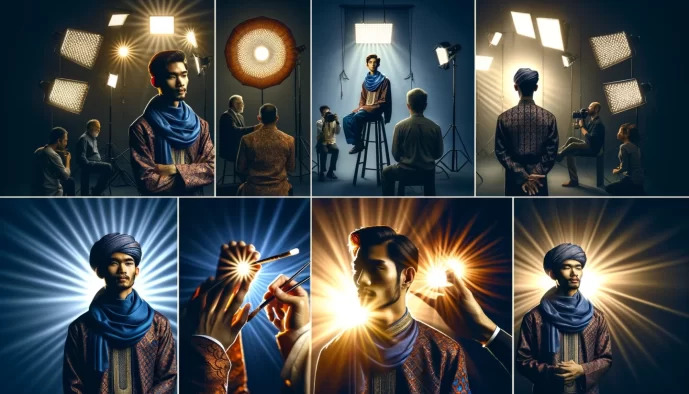Creative Lighting Techniques
Unlock the secrets of light in photography, from basics to advanced techniques.

Understanding Light in Photography
The Nature of Light
Photography is painting with light. The essence of an image is carved by the intensity, color, and contrast of light. Mastering photography starts with understanding that light is a spectrum, with each wavelength corresponding to a different color.
Hard vs. Soft Light
Hard light creates sharp shadows and high contrast, often seen in bright sunlight. Soft light, on the other hand, is diffused, producing gentle transitions between light and dark. It’s the nuanced interplay between these two that can make or break a photograph.
Direction and Quality of Light
The direction from which light hits a subject can dramatically alter its appearance. Sidelight emphasizes texture, while backlight can create silhouettes. The quality of light, whether it’s the diffused glow of an overcast day or the harsh midday sun, shapes the mood of the image.
Camera Settings for Optimal Exposure
ISO
ISO measures a camera’s sensitivity to light. Low ISO values (e.g., 100) are ideal for bright conditions, while high ISO (e.g., 3200) assists in low light situations. Beware of the grain that comes with higher ISO settings.
Shutter Speed
Shutter speed determines how long the camera’s sensor is exposed to light. Fast speeds (e.g., 1/1000s) freeze motion, while slow speeds (e.g., 1s) can create blur, conveying movement or passing time.
Aperture
Aperture controls the size of the lens’ opening, affecting the amount of light reaching the sensor and the depth of field. A wide aperture (e.g., f/2.8) yields a shallow focus, while a narrow aperture (e.g., f/16) brings more of the scene into sharp focus.
The Golden Hour and Blue Hour
Harnessing the Magic of Golden Hour
The golden hour casts a warm, diffused light that flatters subjects and landscapes alike. This period just after sunrise or before sunset provides a natural, softbox-like effect.
Embracing the Mood of Blue Hour
The blue hour offers a cooler, ethereal light, perfect for capturing the tranquility of twilight. The subtle gradients in the sky during this time are a gift to photographers who seek moodiness in their imagery.
Artificial Lighting Techniques
Flash Photography Basics
A flash can illuminate a scene with a burst of light. On-camera flash may lead to flat lighting, while off-camera flash offers more control and dimensionality. It’s the strobist’s scalpel in an otherwise blunt world of lighting.
Continuous Lights and Modifiers
Continuous lighting allows real-time adjustments and is indispensable for video. Modifiers such as softboxes and umbrellas can alter the light’s hardness and spread, crafting the desired atmosphere.
Light Shaping and Control
Reflectors and Diffusers
Reflectors bounce light onto a subject, filling in shadows and controlling contrast. Diffusers scatter light, simulating the softness of an overcast day, essential for a flattering portrait.
Flags and Gobos
Flags block unwanted light, preventing flare and deepening shadows. Gobos (go-betweens) shape light into patterns, adding texture and narrative elements to the scene.
Creative Lighting Strategies
Silhouettes and Backlighting
Silhouettes strip subjects down to their essence, leveraging strong backlighting against a brighter background. This technique is all about shape and form, devoid of the distraction of color and texture.
High Key and Low Key Lighting
High key lighting is characterized by minimal shadows and a bright, even tone suitable for a lighthearted feel. Low key lighting is the opposite, emphasizing shadows and mood for a more dramatic or somber effect.
Post-Processing and Light Enhancement
Adjusting Exposure and Contrast
Post-processing is a chance to rectify or refine exposure and contrast. It’s the digital darkroom where one can dodge and burn with precision, sculpting the image into its final form.
Playing with Color and Saturation
Adjusting color balance and saturation can transform the emotional impact of a photo. The play of warm and cool tones dictates the visual temperature and can turn an ordinary photo into a poignant story.
In conclusion, mastering light is a perpetual juggling act—a balance of science and art. It’s the understanding of physics, blended with an artist’s eye for emotion and drama, that elevates the ordinary to the sublime. Whether through the soft embrace of morning light or the artificial wizardry of a well-placed strobe, the dance with light is what makes photography an endless, fascinating pursuit.